
The House of Pazzi were a noble Florentine family. Their main trade during the fifteenth century was banking. In the aftermath of the Pazzi conspiracy in 1478, members of the family were banished from Florence and their property was confiscated; the family name and coat-of-arms were permanently suppressed by order of the Signoria.
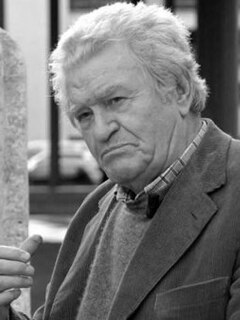
Pietro Cascella was an Italian sculptor. His principal work consisted of large monumental sculptures, including the International Monument to the Victims of Fascism in the Auschwitz II-Birkenau death camp in Poland (1957–1967), and an underground mausoleum for Silvio Berlusconi at his villa in Arcore in the 1980s.
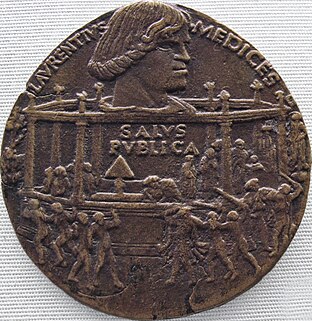
The Pazzi conspiracy was a plot by members of the Pazzi family and others to displace the Medici family as rulers of Renaissance Florence.
Neo-expressionism is a style of late modernist or early-postmodern painting and sculpture that emerged in the late 1970s. Neo-expressionists were sometimes called Transavantgarde, Junge Wilde or Neue Wilden. It is characterized by intense subjectivity and rough handling of materials.

Achille Bonito Oliva is an Italian art critic and historian of contemporary art. Since 1968 he has taught history of contemporary art at La Sapienza, the university of Rome. He has written extensively on contemporary art and contemporary artists; he originated the term Transavanguardia to describe the new direction taken in the late 1970s by artists such as Sandro Chia, Francesco Clemente, Enzo Cucchi, Nicola De Maria, and Mimmo Paladino. He has organised or curated numerous contemporary art events and exhibitions; in 1993 he was artistic director of the Biennale di Venezia.

Pietro Consagra was an Italian sculptor. In 1947 he was among the founding members of the Forma 1 group of artists, who advocated both Marxism and structured abstraction.
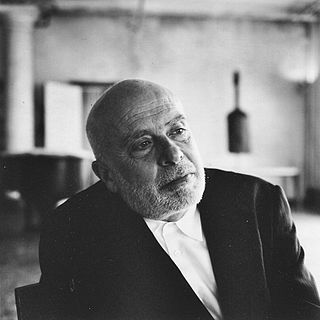
Francesco Clemente is an Italian contemporary artist. He has lived at various times in Italy, India and New York City. Some of his work is influenced by the traditional art and culture of India. He has worked in various artistic media including drawing, fresco, graphics, mosaic, oils and sculpture. He was among the principal figures in the Italian Transavanguardia movement of the 1980s, which was characterised by a rejection of Formalism and conceptual art and a return to figurative art and Symbolism.
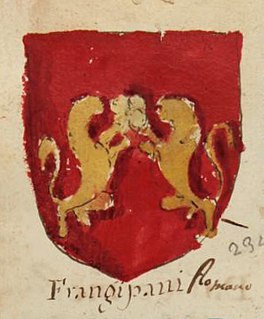
The Frangipani family was a powerful Roman patrician clan in the Middle Ages. The family was firmly Guelph in sympathy. The name has many spellings, which include Frangipane, Freiapane, Fricapane and Fresapane. In his Trattatello in laude di Dante, Boccaccio traces the descent of Dante from the family.

Flash Art is a contemporary art magazine, and an Italian and international publishing house. Originally published bilingually, both in Italian and in English, since 1978 is published in two separate editions, Flash Art Italia (Italian) and Flash Art International (English). Since September 2020, the magazine is seasonal, and said editions are published four times a year.

Charles Coleman was a British landscape and animal painter, born in Pontefract, in Yorkshire, England. He was active principally in Rome, where was an important influence on Nino Costa and made a significant contribution to the formation of the Campagna Romana School of painting.

Enzo Cucchi is an Italian painter. A native of Morro d'Alba, province of Ancona, he was a key member of the Italian Transavanguardia movement, along with his countrymen Francesco Clemente, Mimmo Paladino, Nicola De Maria, and Sandro Chia. The movement was at its peak during the 1980s and was part of the worldwide movement of Neo-Expressionist painters.

Mimmo Paladino is an Italian sculptor, painter and printmaker. He is a leading name in the Transvanguardia artistic movement and one of the many European artists to revive Expressionism in the 1980s.
Transavantgarde or Transavanguardia is the Italian version of Neo-expressionism, an art movement that swept through Italy and the rest of Western Europe in the late 1970s and 1980s. The term transavanguardia was coined by the Italian art critic, Achille Bonito Oliva, originating in the "Aperto '80" at the Venice Biennale, and literally means beyond the avant-garde.
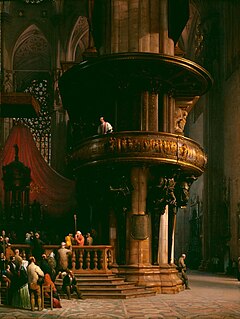
Luigi Bisi was an Italian architect and painter. He was the most notable member of an artistic family.

The Landi were a noble family from Piacenza, in northern Italy. From 1551 to 1582, they were princes of the Val di Taro, now in the province of Parma, at that time in papal territory. Their principality is sometimes called Lo Stato Landi ; although the term is not well known, there is substantial documentation of it in the Archivio Segreto Vaticano, in the Vatican City.
Artiscope is a Brussels art gallery specialized in contemporary American and European artists. Artiscope Gallery has organized exhibitions in collaboration with many museums in Belgium and Germany.

Paolo De Grandis is an Italian contemporary art curator and president of PDG Arte Communications. He lives currently in Venice.
Giuseppe Ducrot is an Italian sculptor and member of the Pontifical Academy of Fine Arts and Letters of the Virtuosi al Pantheon.

Leoncillo Leonardi, commonly known as Leoncillo, was an Italian sculptor who worked principally in glazed ceramics, often large-scale, and often using vivid colours. Until the mid-1950s his work was mostly figurative, but became more abstract thereafter. In 1946 he was among the founding members of the Nuova Secessione Artistica Italiana, which soon became the Fronte Nuovo delle Arti. He received the Premio Faenza in 1954 and again in 1964, and won the sculpture prize at the Biennale di Venezia of 1968. His work was also part of the sculpture event in the art competition at the 1948 Summer Olympics.
Nicola De Maria is an Italian painter living and working in Torino, Italy. De Maria is known for his abstract figurative works, which have been characterized as lyrical and colourful.















